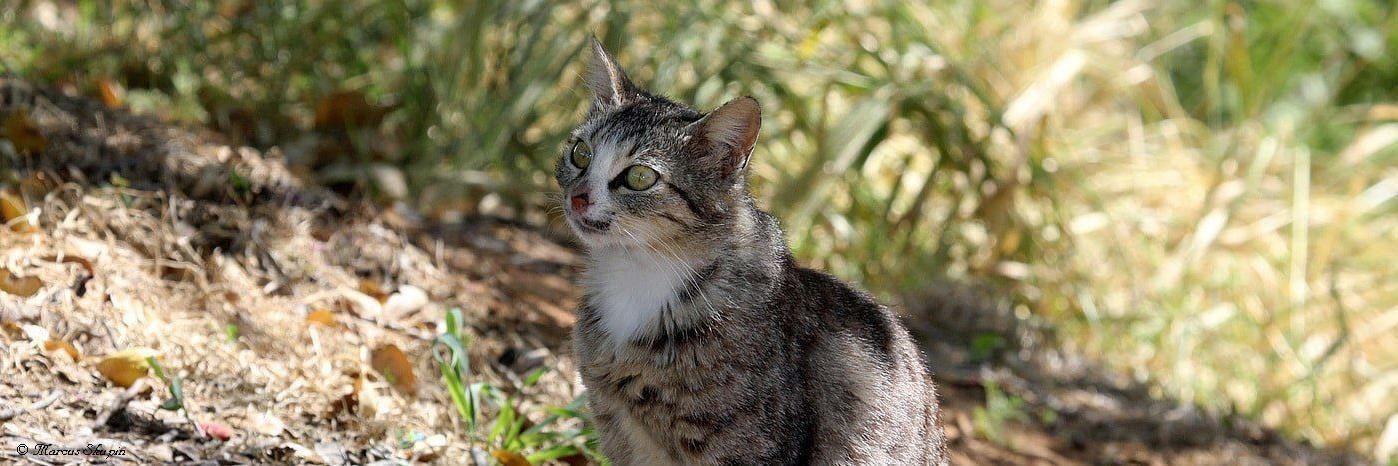Chapter V
CHAPTER V
Flesh-Eating Animals: the Felines, or the Cat Tribe
So far most of the animals I have described to you are vegetarians, that is, they eat vegetables of all kinds, for even leaves, herbs, and grass may be classed as vegetables. These animals are the elephant, the buffalo, the deer, the antelope, and others. The bear is the only animal I have so far described to you (in Book I) that eats both vegetables that is, the roots of trees and the flesh of other animals as well.
But now I shall describe to you quite a different class of animals, namely, animals that eat only meat. Among these animals the most important group is the Cat Tribe, or the felines, as they are sometimes called. They possess many of the qualities of the ordinary cat.
The principal felines are the tiger, the lion, the leopard, the puma, and the jaguar. All felines have a special kind of fangs, tongue, claws, and paws, which I shall now describe in detail.
The Feline Has Strong Fangs
Besides the ordinary teeth, every feline has two pairs of strong fangs which look like big projecting teeth. One pair of fangs is placed on the upper jaw, pointing downward; they are wide apart. The other pair of fangs is placed in the lower jaw, pointing upward; they are not quite so far apart as the fangs of the upper jaw. Why? So that the animal can close its mouth comfortably without striking the lower fangs against the upper fangs.
These fangs are three to four inches long in a tiger or a lion; they are not quite so big in a leopard or other feline. The fangs of the tiger or the lion are so strong that he can hold down a heavy bullock by gripping it with his fangs. He can also drag the bullock along the ground by gripping it in that way, and can use the fangs to tear out a large piece of meat from the body of his prey.
When the tiger or the lion gets a piece of meat into his mouth, he uses the upper fangs to pierce the meat: that is, the meat lies on the ordinary teeth on the under jaw, and the two fangs of the upper jaw come down on the meat and cut it into two or three pieces. The tiger or the lion could chew the meat a little more, with the help of his ordinary teeth, but he does not need to. Every animal of the Cat Tribe has a strong digestion; so the tiger or the lion merely cuts up the meat a few times with his fangs and then swallows it.
The Feline's Tongue is Rough
A feline's fangs, however, are too big to tear off small pieces of meat from a bone. So it uses its tongue to scrape off the small pieces of meat. That is the reason why a feline's tongue is very rough. So again you see, as I told you in Book I, that every animal has the gift it needs. If the feline did not have a rough tongue, it could not eat the small pieces of meat on a bone; and so a portion of its food would be wasted. No inhabitant of the jungle wastes food. It is only we who waste food.
The Feline's Claws are Retractile
The claws of every feline are retractile. That is, the claws can be drawn in, or sheathed, whenever the animal desires; also, the claws can be thrust out, whenever the animal desires to do that.
Why is it necessary for a feline to be able to do both to draw in its claws, and to thrust them out?
Because when the animal needs food, it must thrust out the claws to seize it. But in just running about in the jungle, it does not need to use its claws; so it draws them in. In fact, if it did not draw in its claws then, the claws would soon be worn out by rubbing against the ground. And even if the claws were growing all the time, they would be also wearing off all the time. So to keep the claws sharp for use only when the animal wants to seize something, it keeps the claws drawn in at other times.
Here I ought to tell you that a dog's claws are quite different from the claws of a feline, even from those of an ordinary cat. The cat's claws are of course retractile, as I have just described to you. But a dog's claws are rigid; that is, they are stiff and thrust out all the time. Why? Because the dog does not use its claws. It seizes its food with its mouth, not with its claws. It even defends itself with its mouth, that is, with its teeth.
But a feline uses its claws to seize its food, and even to defend itself. You may have noticed that even an ordinary cat defends itself with its claws. When a dog chases a cat and corners it, the cat turns and defends itself with its claws.
Once upon a time, many, many hundred years ago, the dog did use its claws; they were then retractile. But the dog stopped using its claws; then they became rigid. The dog lost the power of drawing in its claws.
In our own bodies, if we do not use a particular gift for a long time, we lose the power of using that gift. When we are born, our left hand is just as good as our right hand. But because we do not use the left hand much in doing things, we lose the power of using it quite as well as we use the right hand. Little boys and girls should practice using the left hand. Then if by some accident the right hand is lost, they would not be quite helpless.
As for the felines, they retain the full power of their claws by constant use. So, because the claws are very useful, every feline takes care of its claws, especially the tiger. Why, the tiger cleans his claws every day! In the jungle there are many trees that have a soft bark. So the tiger goes to one of these trees every day, and digs his claws into the bark. Then he draws his claws sideways along the bark, and that cleans out the claws. The tigress also cleans her claws every day in the same manner.
Some little boys and girls do not clean their nails every day. Then sometimes a piece of dirt gets in under a nail and causes a sore. But the tiger and tigress are wiser. If part of a piece of meat that they have torn up were to remain under a claw, it would fester and cause a sore. So the tiger and tigress clean their claws every day.
The Feline Has Padded Paws
The paws of every feline have also a special quality. The under part of each paw is thickly padded with powerful muscles. That gives the feline three advantages.
First advantage: it enables the feline to stalk its prey. That is, the feline can creep up to its prey quite silently. As its paws are padded, they make no sound on the ground just as your footfall makes no sound when you wear rubbers over your shoes.
Second advantage: the padded paw enables the feline to strike down its prey with a severe blow. When it wants to strike down its prey, the feline hardens the muscles under its paw; the blow of its paw is then something like that of a hammer. A tiger has often been known to smash the skull of a buffalo with a single blow of its paw.
Third advantage: the padded paws enable a feline to leap farther. After a feline has crept up as near to its prey as it can, it has still to leap upon its prey to seize it. Then the muscles under the paws act like springs, and enable the feline to give a big leap. Even in running, the muscles act somewhat like springs. You must have noticed that, in running, a dog gallops, but a cat bounds. That is, the dog moves its legs very quickly, but each space of ground it covers is not very long. A cat moves its legs not quite so quickly, but the space of ground it covers at each bound is much longer. The cat and all felines can give a bigger bound because of the muscles under their paws.
Having told you all the qualities common to animals of the Cat Tribe, I shall now describe some of these animals in detail.

